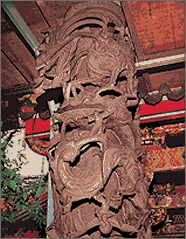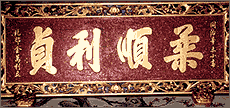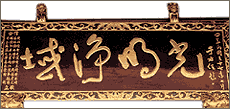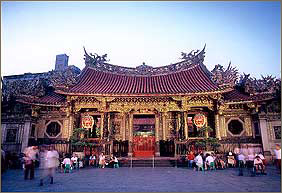 |
 |

Founding Year : 1738
God Worshipped : Guanyin Bodhisattva
Religion : Buddhism
Relic Classification : 2nd Degree Relic
Location : 211, Kwangchow St, Wanhua District, Taipei
|
|
|
|
|

Lungshan Shih or Lungshan Temple was founded by a merchant from Chuanchow. In
1738 the merchant brought from Lungshan Temple of Anhai Village, Tsin-chiang County,
Chuanchow Prefecture , a statue of Guanyin Bodhisattva to Taiwan. Then it was
in "Moun-gar" where was built a temple called Lungshan Shih to worship
Guanyin Bodhisattva.
With the elapse of time, the Temple has dramatically suffered from a series
of big earthquakes, storms, and the Sino-French War. Up to the Japanese occupation
of Taiwan, the Temple was already devastatingly ruined.
The then abbot of the Temple by the name of Fu Tze (secular name is Wu Chan-ming
) led a frugal life and saved every penny. In 1919 abbot Fu Tze donated his
saving of over 7,000 yuan (dollars) to rebuild the broken Temple. His benevolence
and kind-heartedness moved his followers to make some contributions. Under
the auspices of the District Magistrate Wu Chang-tsai, the reconstruction
project started in 1920 and came to completion in 1924. By then the old Temple
of the Ching dynasty was renovated into the present looking of Lungshan Temple.
On June 8, 1945, the middle hall of the Temple was bombed. The explosion of
the burning bomb tore the Temple's middle part into pieces. In 1985, the Ministry
of the Interior made a public announcement, listing the Temple as a Second
Degree National Relic. After Taiwan's restoration, the Lungshan Temple was
used as a "Preparatory Office to Welcome the Motherland" and other
temporary government offices.
|


|

Though Lungshan Shih is commonly regarded as a temple mixing Buddhism and Taoism, it worships mainly Guanyin Bodhisattva of Buddhism. Guanyin is actually a Han language translation from the Sanskrit Buddhist sutra.
Guanyin has become one of the most popular
Buddha since Buddhism was introduced to
China. Guanyin, assuming different names,
is also called variously as Guanyin Pu-sha
, Guanyin Ta-shih, Nanhai Guan-shih-yin
, Guan-shih-yin, Guan-zih-tsai ,and Guanyin
Ma. Guanyin is noted for her benevolence,
mercy, and willingness to save those in
difficulties.
|
 |

Facing the north, Lungshan Temple was founded during the Chien-long period of the Ching dynasty. Its architecture follows the tri-hall style: a front hall, a middle hall, and a rear hall. The Temple had beautiful structures, grand architecture, ornately carved pillars and eves, as well as brilliant golden colors. Among them, the Lungshan Temple in "Moun-gar" (or Wanhua) can boast the biggest and the most grandeur. A temple of such a scale can hardly be found even in Japan.
Lien Ya-tang in his book entitled "Refine Rhetoric" says that in most big temples in Taiwan, the main pillars are usually finely carved with a dragon writhing on each of them. All those expensive, ornately carved pillars are the fine works of engraving masters from Chuanchow. Lungshan shih can be said the quintessence of fine arts. The most specific of the Temple is the Bell-and-Drum Tower, whose ceiling is formed like the top of a sedan. It also looks like a general's helmet, so it is also called "helmet-style ceiling", which is hardly seen in Taiwan.
|
|
|
|
|